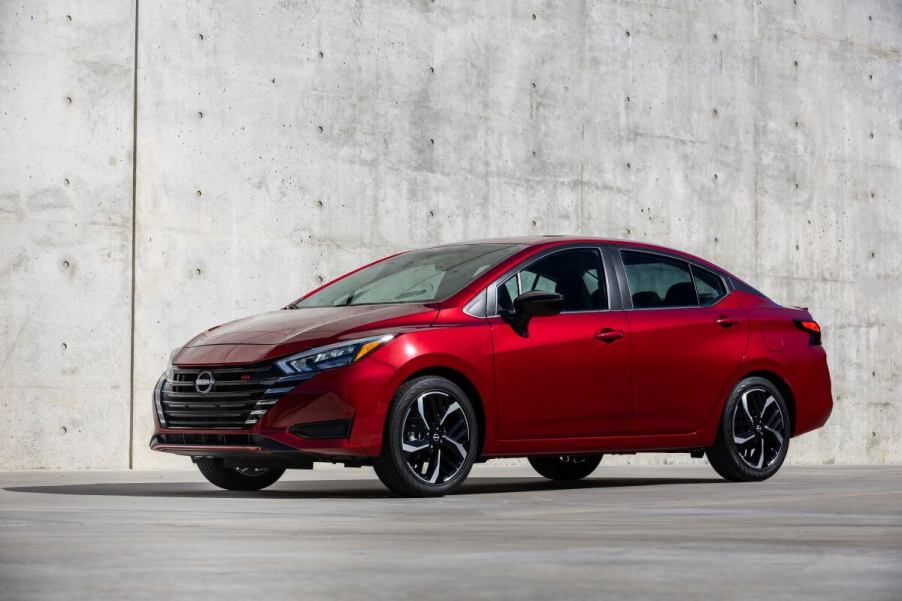
4 Reasons the Cheapest Car Could Be a Perfect Fit
Despite many automakers looking to phase out their sedan lines, Nissan still offers five options for the 2023 model year. The cheapest is the subcompact Versa with a base S trim starting at $15,730.
Even if you spring for the well-equipped Nissan Versa SR, you could pay less than $20,000 for a new model. Shoppers typically associate such low prices with bargain-bin interior quality with few technology offerings. However, one trusted auto website has several reasons why the Nissan Versa is worth every penny.
1. Value
TrueCar thinks all three trims of the Nissan Versa offer a good bang for your buck, especially the middle-ground SV model. It starts at $19,020 and features smartphone integration along with a wireless charging pad. It also gains a center console with an armrest, plus some premium cloth seats.
The infotainment setup of the Nissan Versa S lacks Apple CarPlay or Android Auto, but Bluetooth serves as a sufficient substitute. It also has a 7-inch touchscreen and a basic four-speaker stereo.
If you option it with the continuously-variable transmission (CVT) instead of the standard five-speed manual, its starting price rises to $17,400. The CVT is standard equipment on both the Versa SV and SR trims.
The Nissan Versa SR has a slightly bigger touchscreen, two extra audio speakers, heated seats, and a Wi-Fi hotspot. It also rides on 17-inch wheels instead of the standard 16 inches, along with LED headlights.
2. Great gas mileage
Every Nissan Versa has front-wheel drive and the same four-cylinder engine capable of 122 hp and 114 lb-ft of torque. The CVT-equipped models can get up to 32/40 mpg city/highway. Even if you prefer the manual transmission, you’re still likely to get 27/35 mpg city/highway.
The Versa’s puny horsepower output doesn’t provide optimal acceleration, but TrueCar says this sedan has a satisfying ride quality. The latest redesign (for 2020 and onward) left the Nissan Versa with a retuned power steering system and a smoother suspension.
3. Segment-leading safety suite

The Nissan Versa has one of the most extensive advanced driver’s safety systems you’ll find at this price point. Each trim includes forward collision warning, forward automatic emergency braking, lane departure warning, and pedestrian detection. Automatic high beams are also included, and models with the CVT gain rear automatic emergency braking.
The Nissan Versa SV is better equipped with blind-spot monitors, rear cross-traffic alert, a rear-seat reminder, and a driver attentiveness monitoring system. The Nissan Versa SR has all these features, plus adaptive cruise control.
4. Generous front seat and trunk area
The Nissan Versa has over 39 inches of headroom and more than 44 inches of legroom in the cabin, more than most of this car’s rivals. TrueCar is also happy to report that the seats provide excellent support.
The Versa seats up to five riders, though the second row isn’t nearly as accommodating. Backseat riders have just 31 inches of legroom and a little over 36 inches of headroom. Fortunately for some, the Versa makes up for this in terms of cargo capacity.
The standard trunk has approximately 14.7 cubic feet of space, and the available center console has big cubbies inside. The CVT-equipped Versa has a split-folding rear seat that expands its cargo area to approximately 15 cubic feet. However, unlike some of its segment competitors, the Versa isn’t available as a hatchback.
The Nissan Versa definitely isn’t as flashy or well-equipped as some rivals. However, we appreciate that it offers a lot of safety tech and one of the most fuel-efficient engines without hybrid technology. In a world where inflation and used car prices increase with little warning, the Versa is a gift for frugal shoppers.



